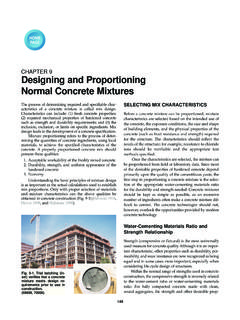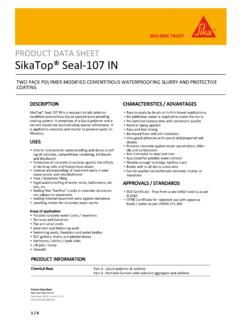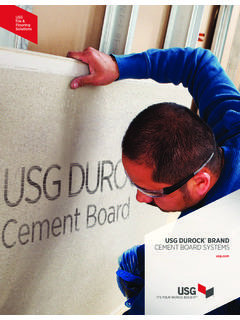Transcription of CHAPTER 9 PHYSICAL PROPERTIES OF LIGHTWEIGHT …
1 6-1 CHAPTER 6 PHYSICAL PROPERTIES of Structural LIGHTWEIGHT Concrete The information present in CHAPTER 6 and 7 is also covered in a more general way in: ACI 213R-03 Guide for Structural LIGHTWEIGHT Aggregate Concrete and ASTM 169 D LIGHTWEIGHT Concrete and Aggregates Both are excellent references. April 2007 Expanded Shale, Clay & Slate Institute (ESCSI) 2225 E. Murray Holladay Rd, Suite 102 Salt Lake City, Utah 84117 (801) 272-7070 Fax: (801) 272-3377 6-2 CHAPTER 6 Definition of Terms Compressive Strength Density Density of the Constituents of Concrete Mixtures Equilibrium Density-Self Loads Specified Density Concrete Absorption Internal Curing Introduction Contact Zone Implication of Contact Zone on Failure Mechanisms Permeability Pozzolanic characteristics History Pozzolanic Terminology and PROPERTIES Influence on PROPERTIES of Concrete Pozzolanic Reaction in the Contact Zone Heat Flow characteristics Thermal Conductivity LIGHTWEIGHT Concrete High Strength LIGHTWEIGHT Concrete High Strength Specified Density Concrete Specific Heat Thermal Diffusivity Fire Resistance General High Strength LIGHTWEIGHT Concrete High Strength Specified Density Concrete Refractory Concrete Abrasion Resistance Appendix 6A Standard Test Method for Determining Density of Structural LIGHTWEIGHT Concrete.
2 ASTM C 567-05. Appendix 6B Jet Exhaust Damaged Concrete , Hronaka and Malvar, Concrete International, October 1998. Appendix 6C Refractory Concrete Papers Appendix 6D ESCSI Publication #4362 Internal Curing Using Expanded Shale, Clay and Slate LIGHTWEIGHT Aggregate . Appendix 6E CHAPTER 46 LIGHTWEIGHT Concrete and Aggregates , Significance of Tests and PROPERTIES of Concrete and Concrete-Making Materials, ASTM Special Technical Publication 169D. 6-3 CHAPTER 6 PHYSICAL PROPERTIES OF STRUCTURAL LIGHTWEIGHT CONCRETE This CHAPTER covers some of the PHYSICAL PROPERTIES of LIGHTWEIGHT concrete. The information is based on many laboratory studies and records of a large number of existing structures that have provided satisfactory service for more than 85 years. Typically, PROPERTIES of LIGHTWEIGHT concrete have been compared with those of normalweight concrete, and usually the comparison standard has been a single normalweight material.
3 With several million cubic yards of LIGHTWEIGHT concrete being placed each year and the fact that normalweight concrete also has an intrinsic variability ; such a comparison of PROPERTIES is no longer appropriate. Definition of Terms Concrete, all LIGHTWEIGHT -Concrete in which both the coarse- and fine-aggregate components are LIGHTWEIGHT aggregates. (Deprecated term-use preferred term; concrete, LIGHTWEIGHT ; concrete, structural LIGHTWEIGHT ; or concrete, specified-density.) Concrete, high-strength LIGHTWEIGHT -Structural LIGHTWEIGHT concrete with a 28-day compressive strength of 6000 psi (40 MPa) or greater. Concrete, Insulating - Insulating concretes are very light non structural concretes, employed primarily for high thermal resistance, incorporate low-density low-strength aggregates such as vermiculite and perlite. With low densities, seldom exceeding 50 lb/ft (800 kg/m ), thermal resistance is high.
4 These concretes are not intended to be exposed to the weather and generally have a compressive strength range from about 100 to 500 psi ( to MPa). Concrete, LIGHTWEIGHT -See concrete, structural LIGHTWEIGHT or specified density. Concrete, normalweight- Concrete having a density of 140 to 155 lb/ft (2240 to 2480 kg/m ) made with ordinary aggregates (sand, gravel, crushed stone). Concrete, sand LIGHTWEIGHT -Concrete with coarse LIGHTWEIGHT aggregate and normalweight fine aggregate. Concrete, semi- LIGHTWEIGHT -Concrete made with a combination of LIGHTWEIGHT aggregates (expanded, clay, shale, slag or slate or sintered fly ash) and normalweight aggregates having an equilibrium density of 105-120 lb/ft (1680-1920 kg/m ) (ACI 216). 6-4 Concrete, specified density-Structural concrete having a specified equilibrium density between 50 to 140 lb/ft (800 to 2240 kg/m ) or greater than 155 lb/ft (2480 kg/m ) (see concrete, normalweight).
5 Specified density concrete (SDC) may consist as one type of aggregate or of a combination of LIGHTWEIGHT and normalweight aggregate. This concrete is project specific and should include a detailed mixture testing program and aggregate supplier involvement before design. Concrete, structural/Insulating -Specifications that call for fill concretes often require compressive strengths and densities in the intermediate range between structural and insulating concretes. These concretes may be produced with high air mixtures and include structural LIGHTWEIGHT aggregate, or sanded insulating LIGHTWEIGHT aggregate mixtures, or they may incorporate both structural and insulating LIGHTWEIGHT aggregates. Compressive strengths from 500 to 2500 psi ( to 17 MPa) are common with thermal resistance ranging between insulating and structural concrete. Concrete, structural LIGHTWEIGHT -Structural LIGHTWEIGHT -aggregate concrete made with structural LIGHTWEIGHT aggregate as defined in ASTM C 330.
6 The concrete has a minimum 28-day compressive strength of 2500 psi (17 MPa), an equilibrium density between 70 and 120 lb/ft (1120 and 1920 kg/m ), and consists entirely of LIGHTWEIGHT aggregate or a combination of LIGHTWEIGHT and normal-density aggregate. Structural LIGHTWEIGHT concretes generally contain aggregates made from pyroprocessed shale s, clays, slates, expanded slags, expanded fly ash, and those mined from natural porous volcanic sources. Structural LIGHTWEIGHT concrete is normally classified by a minimum compressive strength that was jointly established by the ASTM Specification C 330 for LIGHTWEIGHT Aggregates and the Standard Building Code for Reinforced Concrete (ACI 318). The 318 code definition is Structural concrete made with LIGHTWEIGHT aggregate; the equilibrium density at 28 days is usually in the range of 90 to 115 lb/ft (1440 to 1850 kg/m ) and the compressive strength is more than 2500 psi ( MPa).
7 This is a definition, not a specification and project requirements may permit equilibrium densities up to 120 lb/ft (1900 kg/m ), most LIGHTWEIGHT aggregate concrete used in structures have equilibrium unit weights between 100 and 115 lb/ft (1600 to 1792 kg/m ). These definitions are not specifications. Project specifications vary. While LIGHTWEIGHT concrete with an equilibrium density of 70 to 105 lb/ft (1120 to 1680 kg/m ) is infrequently used, most LIGHTWEIGHT concrete has an equilibrium density of 105 to 120 lb/ft (1680 to 1920 kg/m ). Because LIGHTWEIGHT concrete is often project-specific, contacting the aggregate supplier before project design is advised to ensure an economical mixture and to establish the available range of density and strength. 6-5 Contact zone-The expression contact zone includes two distinctly different phenomena (1) the mechanical adhesion of the cementitious matrix to the surface of the aggregate and (2) the variation of PHYSICAL and chemical characteristics of the transition layer of the cementitious matrix close to the aggregate particle.
8 Curing, internal-Internal curing refers to the process by which the hydration of cementitious materials continues because of the availability of absorbed water within the pores of the LIGHTWEIGHT aggregate particle. Density, equilibrium-As defined in ASTM 567, it is the density reached by structural LIGHTWEIGHT concrete (low density) after exposure to relative humidity of 50 + 5% and a temperature of + F (23 + 2 C) for a period of time sufficient to reach a density that changes less than in a period of 28 days. Density, oven dry-As defined in ASTM C 567, the density reached by structural LIGHTWEIGHT concrete after being placed in a drying oven at 230 + 9 F (110 + 5 C) for a period of time sufficient to reach a density that changes less than in a period of 24 hr. LIGHTWEIGHT -The generic name of a group of aggregates having a relative density lower than normal-density aggregates. The generic name of concrete or concrete products having lower densities than normalweight concrete products.
9 LIGHTWEIGHT aggregate concretes are broadly divided by ASTM into three groups based upon their use and PHYSICAL PROPERTIES , structural, structural/insulating and insulating concrete density, thermal conductivity and compressive strength ranges normally associated with each class of concrete are summarized in Table TABLE LIGHTWEIGHT Aggregate Concrete Classified According to Use and PHYSICAL PROPERTIES according to ASTM C 330 and C 332. Class of LIGHTWEIGHT Aggregate Concrete Type of LIGHTWEIGHT Aggregate used in Concrete Typical Range of LIGHTWEIGHT Concrete Density lb/ft (kg/m ) Typical Range of Compressive Strength Psi (MPa) Typical Range of Thermal Conductivities Btu ft2 F (W/m K). Structural Structural-grade LWA C 330 90 to 115 (1440 to 1840) at equilibrium >2500 (> 17) not specified in C 330 Structural/Insulating Either structural C 330 or insulating C 332 or a combination of C 330 and C 332 45 to 90 (720 to 1440) at equilibrium 500 to 2500 ( to 17) C 332 from ( ) to ( ) oven dry Insulating Insulating-grade LWA C 332 15 to 50 (240 to 800) oven dry 100 to 500 ( to ) C 332 from ( ) ( ) oven dry 6-6 Compressive Strength Compressive strength levels commonly required by the construction industry for design strengths of cast-in-place, precast, or prestressed concrete are economically obtained with LIGHTWEIGHT concrete (Shideler 1957; Hanson 1964; Holm 1980a).
10 Design strengths of 3,000 to 5,000 psi (21 to 35 MPa) are common. In precast and prestressing plants, design strengths above 5,000 psi (35 MPa) are usual. In several civil structures, such as the Heidrun Platform and Norwegian bridges, concrete cube strengths of 8700 psi (60 MPa) have been specified (fib 2000). All aggregates have strength ceilings, and with LIGHTWEIGHT aggregates, the strength ceiling generally can be increased by reducing the maximum size of the coarse aggregate. As with normalweight concrete, water-reducing plasticizing and mineral admixtures are frequently used with LIGHTWEIGHT concrete mixtures to increase strength and workability as well as to facilitate placing and finishing . ACI 213R-03. Density The fresh density of LIGHTWEIGHT concretes is a function of mixture proportions, air contents, water demand, particle density, and moisture content of the LIGHTWEIGHT aggregate.







